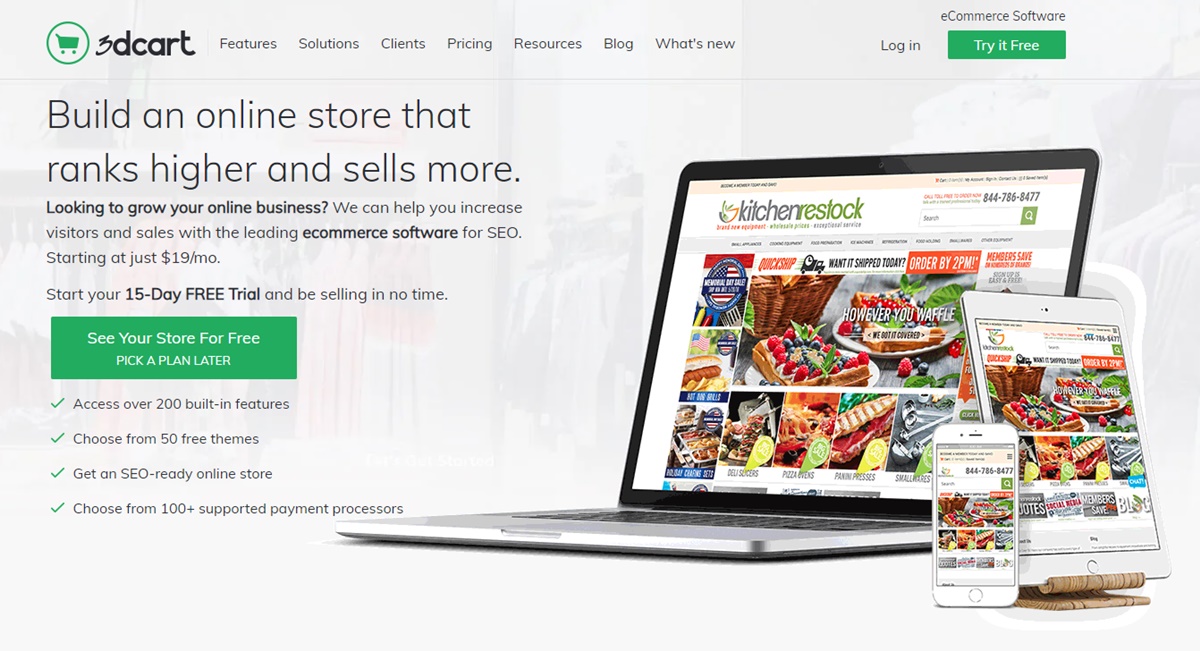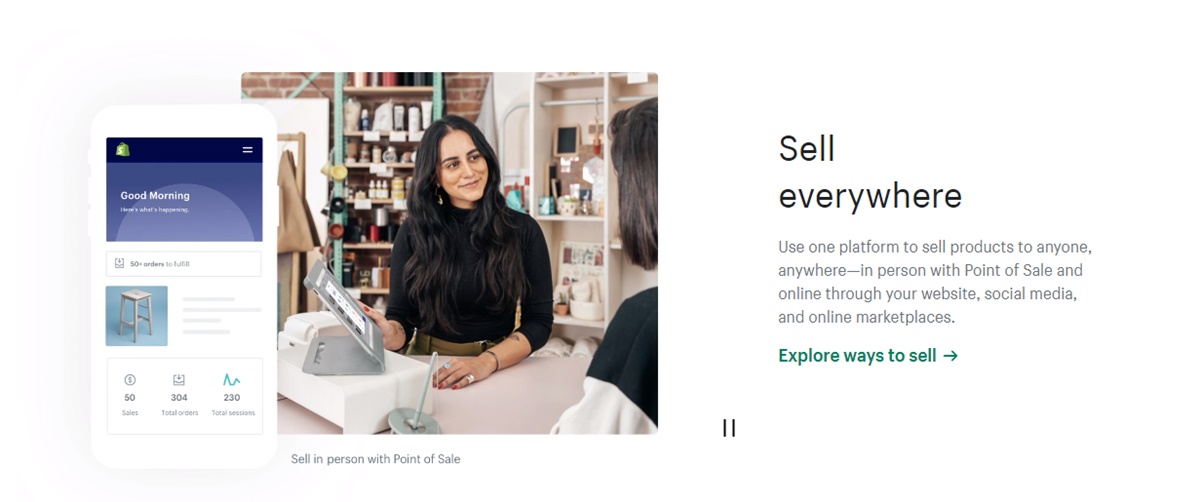Comparing 3dcart and Shopify: Two eCommerce Platforms
A good eCommerce platform can do more than just sell your products; it can facilitate the creation of your online store in a simple, enjoyable, and cost-effective manner. When comparing 3dcart vs. Shopify, these are two of the most well-known names in the industry, which may explain how you ended up here.
Shopify is a leading eCommerce platform, whereas 3dcart's backend is affordable and robust. Each has its own advantages and disadvantages, as well as ideal users. Having said that, I am aware that choosing the best platform for your online business can be difficult. This is why I tested Shopify and 3dcart before writing this article.
I'm going to compare and contrast 3dcart and Shopify so that you can determine which e-commerce platform is the best option. Let's begin the ultimate battle between 3dcart and Shopify!
What is 3dcart

To begin, 3dcart is a feature-rich eCommerce platform that allows users to build and launch an online store. It is trusted and used by over 22,000 merchants worldwide. On the whole, 3dcart has all the features you need to start an eCommerce business. With the platform, you can choose from a wide range of mobile-optimized themes and customize to your own needs using coding.
3dcart may not have too many users, but it is still a main player in the eCommerce industry. It allows sellers to house a category of products and accept payments from customers. You can also manage your business with inventory, marketing, shipping, and SEO. There are four standard pricing plans with different levels of advanced features. For larger companies, 3dcart has an enterprise plan as well.
What is Shopify

Shopify, on the other hand, is a well-known eCommerce solution, which has grown steadily since 2006 to host more than 1 million stores in the world. It gives you the ability to create, customize, and launch your online store with many included features to streamline your work process.
Using Shopify, you can choose from one of its professionals and responsive themes to change your storefront. All is done on a simple drag and drop dashboard that you can immediately see what you have adjusted. In your store, you can add products, manage inventory, and give customers a full experience from visiting to purchasing.
You also get access to an app store and a theme store to add functionality or renew the storefront. There are many gateways to integrate, as well. If you decide to sell on Shopify, there are three basic pricing plans and two special plans for existing websites or enterprises level. There is a mobile app so you can manage the store on the go too.
Pros and Cons of 3dcart and Shopify
3dcart vs Shopify compare
Both 3dcart and Shopify are hosted solutions, so there is no need to seek out a third-party hosting provider. In addition, the requirements are minimal, requiring only a computer, Internet access, and a web browser to run. Nothing requires downloading. Now, we will compare 3dcart and Shopify based on the features that are most important when choosing an eCommerce platform.
Functionality compare

Sales features compare

Obviously, sales features are essential for any eCommerce company. Both 3d cart and Shopify offer online store functionality, but which platform will help you generate revenue? Let's see.
While 3dcart's design is lacking, its sales features are robust. You have a robust backend with space for an unlimited number of products and shipping integrations with UPS and FedEx. In addition, 3dcart includes ready-to-use SEO features, allowing your website to rank higher in search engine results. However, there is no mobile application, so you cannot manage everything while on the go.
When it comes to online selling, Shopify's slick interface offers a good deal. It offers unlimited products on all plans, abandoned cart recovery, a mobile app, and an app store with a vast selection of third-party and in-house integrations to simplify the workflow.
Despite 3dcart's robust features, Shopify remains the most comprehensive eCommerce platform with the best sales tools. Although I must give credit to 3dcart for the SEO prompts, Shopify offers a vast app store to streamline accounting, marketing, and shipping, among other functions.
Store design compare

For a store to be successful, customers must initially enjoy shopping there. Does your store appear expert? Is it simple to locate a particular product? For website builders such as 3dcart and Shopify, the answers to such questions can be found in their template designs.
3dcart offers 93 theme templates with $99 to $149 premium options. More than fifty of these are mobile-responsive, meaning your store would look good when viewed on a mobile device. While the majority of designs are appealing (if a bit dated) and consistent with the brand, some still lack fundamental features such as navigation menus. There is no mobile editor, so mobile design is not possible.
You must primarily edit 3dcart themes using the HTML and CSS editor. It is possible to enable a drag-and-drop editor for HTML themes upon request. On the customize tab of a selected theme, you can only change a few colors and fonts; therefore, it is not the best editor available.
Shopify offers 72 themes, of which eight are free and sixty-four are premium with prices ranging from $140 to $160. However, each of these themes has an improved layout and responsiveness across all devices. Each theme has multiple variations, so you receive two or three themes for the price of one. Additionally, the themes include industry-specific features that will save you time when designing your storefront.
Where Shopify excels 3dcart is the company's mobile application. You can edit your store from your mobile device, which is ideal for modern business owners. It is also possible to drag and drop content blocks, categories, and buttons when editing themes. Liquid-based code editors are also available for more advanced technological changes.
Shopify is the winner in terms of store design due to its superior design and easy customization for both non-technical and technical users. You can modify your online store to suit your needs without having to learn web programming.
Payment methods

3dcart can connect with over 100 payment gateways. It does not have an in-house payment solution, but they don't charge transaction fees so it is considered a big win for me. You can connect with top providers like PayPal, Stripe, and Square.
Shopify also can integrate with over 100 payment gateways, and has its own payment gateway called Shopify Payments. If you use Shopify Payments, you won't have any additional transaction fees. Shopify Payments is currently available to users in the US, the UK, Canada, Australia, New Zealand, Japan, Hong Kong, Singapore, Ireland, and Puerto Rico.
Read more: Best Payment Gateways for Shopify
Credit card processing rates are different based on your pricing plans, same with the additional fees for using third-party payment providers. The higher plan you use, the lower these fees are.
In terms of payment methods, 3dcart outshines Shopify with the same number of payment gateways but no transaction fees. This is a better deal if your store does many transactions, especially oversea.
Integrations compare

In addition to its built-in features, 3dcart offers third-party applications that can extend a store's functionality, such as shipping services, tax software, social media networks, and email marketing tools. Its app store features more than 300 integrations, including MailChimp, eBay, and QuickBooks.
In contrast, Shopify has over 4000 apps, both free and paid, developed by third parties and Shopify. Across categories ranging from sales, conversion rates, finance, dropshipping, and productivity, you will likely find a Shopify app that satisfies the eCommerce function you need.
Based on the number of categories and apps, Shopify has the most comprehensive app store, with apps for every eCommerce business need. By testing and experimenting, you are certain to discover inexpensive options that can enhance the functionality of your store.
3dcart vs Shopify: Who is the winner?
Final winner: Shopify

Comments
Post a Comment